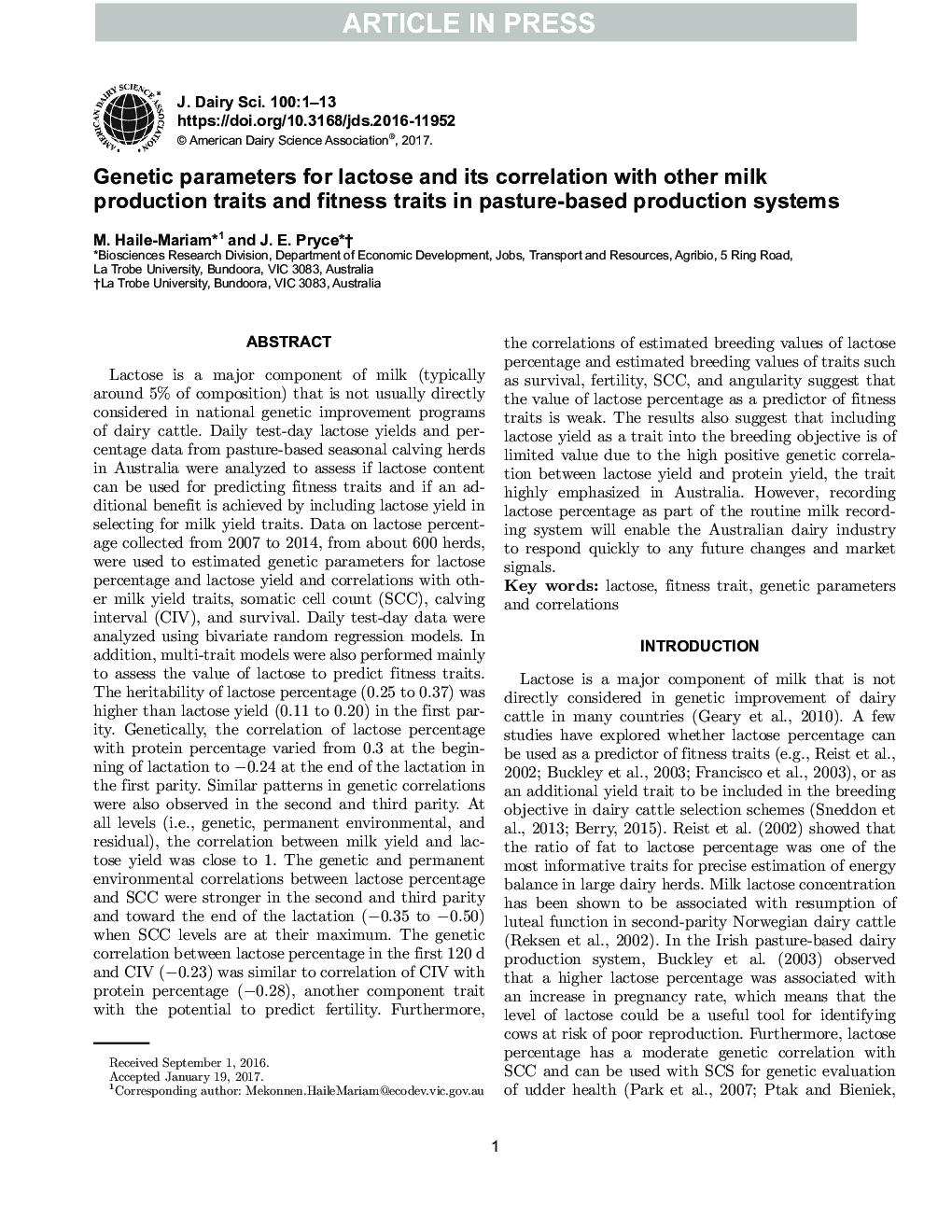| کد مقاله | کد نشریه | سال انتشار | مقاله انگلیسی | نسخه تمام متن |
|---|---|---|---|---|
| 5542171 | 1402515 | 2017 | 13 صفحه PDF | دانلود رایگان |
عنوان انگلیسی مقاله ISI
Genetic parameters for lactose and its correlation with other milk production traits and fitness traits in pasture-based production systems
ترجمه فارسی عنوان
پارامترهای ژنتیکی برای لاکتوز و همبستگی آن با سایر صفات تولید شیر و صفات تناسب در سیستم های تولیدی مبتنی بر مرتع
دانلود مقاله + سفارش ترجمه
دانلود مقاله ISI انگلیسی
رایگان برای ایرانیان
کلمات کلیدی
لاکتوز، صفات تناسب اندام، پارامترهای ژنتیکی و همبستگی،
موضوعات مرتبط
علوم زیستی و بیوفناوری
علوم کشاورزی و بیولوژیک
علوم دامی و جانورشناسی
چکیده انگلیسی
Lactose is a major component of milk (typically around 5% of composition) that is not usually directly considered in national genetic improvement programs of dairy cattle. Daily test-day lactose yields and percentage data from pasture-based seasonal calving herds in Australia were analyzed to assess if lactose content can be used for predicting fitness traits and if an additional benefit is achieved by including lactose yield in selecting for milk yield traits. Data on lactose percentage collected from 2007 to 2014, from about 600 herds, were used to estimated genetic parameters for lactose percentage and lactose yield and correlations with other milk yield traits, somatic cell count (SCC), calving interval (CIV), and survival. Daily test-day data were analyzed using bivariate random regression models. In addition, multi-trait models were also performed mainly to assess the value of lactose to predict fitness traits. The heritability of lactose percentage (0.25 to 0.37) was higher than lactose yield (0.11 to 0.20) in the first parity. Genetically, the correlation of lactose percentage with protein percentage varied from 0.3 at the beginning of lactation to â0.24 at the end of the lactation in the first parity. Similar patterns in genetic correlations were also observed in the second and third parity. At all levels (i.e., genetic, permanent environmental, and residual), the correlation between milk yield and lactose yield was close to 1. The genetic and permanent environmental correlations between lactose percentage and SCC were stronger in the second and third parity and toward the end of the lactation (â0.35 to â0.50) when SCC levels are at their maximum. The genetic correlation between lactose percentage in the first 120 d and CIV (â0.23) was similar to correlation of CIV with protein percentage (â0.28), another component trait with the potential to predict fertility. Furthermore, the correlations of estimated breeding values of lactose percentage and estimated breeding values of traits such as survival, fertility, SCC, and angularity suggest that the value of lactose percentage as a predictor of fitness traits is weak. The results also suggest that including lactose yield as a trait into the breeding objective is of limited value due to the high positive genetic correlation between lactose yield and protein yield, the trait highly emphasized in Australia. However, recording lactose percentage as part of the routine milk recording system will enable the Australian dairy industry to respond quickly to any future changes and market signals.
ناشر
Database: Elsevier - ScienceDirect (ساینس دایرکت)
Journal: Journal of Dairy Science - Volume 100, Issue 5, May 2017, Pages 3754-3766
Journal: Journal of Dairy Science - Volume 100, Issue 5, May 2017, Pages 3754-3766
نویسندگان
M. Haile-Mariam, J.E. Pryce,
